No products in the cart.
The Royal Raindrops Crabapple tree will make a statement for effortless all-season elegance in a small garden. The fuchsia-pink flowers welcome spring with spiky purple leaves. But the tree does not stop with the show.
No, you see tiny red berries replacing the blossoms in late summer. You have birds flocking to the garden, and in fall, the show goes on with purple-lobed foliage that varies in shade from copper, and orange, to plum for beautiful fall color.
Plant Name: Malus spp.
Other Name: Flowering Crabapple, Raindrops Crabapple Tree, Royal Raindrops Crabapple
Plant Type: Flowering Fruit Tree
Native Areas: Asia, Europe, North America
Light Requirement: Full Sun
Watering: Average
Fertilizer: Composted Manure
Toxicity: The seeds are toxic to humans and pets
Temperature: Needs a cold period of 45°F and less
Propagation: Most cultivars are grafted
Growth: 20 feet tall and wide
Soil Type: Loamy Well Drained Soil
USDA Hardiness Zones: 4-8
More About Royal Raindrops Crapabble
There are several cultivars in the Malus genus, with a few called Malus transitoria ‘JFS-kw5’ and many others. Some familiar names are the Royal Raindrops Crabapple, Flowering Crabapple, Royal Raindrops, and many more.
No matter all the scientific info, this tree packs a lot of color punch in the garden throughout the year. The magical show starts in early spring with the new flower buds in bright pink covering the tree.
You see a display of glossy deep purple, deeply lobed leaves changing color to bronze as winter arrives with shiny red berries on the tree. The Royal Raindrops Crabapple tree is self-fertile and can also be monoecious.
So, insects that move from one tree to another will still pollinate them. The pollinated flower buds turn into those gorgeous red berries persisting through winter unless the hummingbirds eat them.
Royal Raindrops Crapabble Care Guide
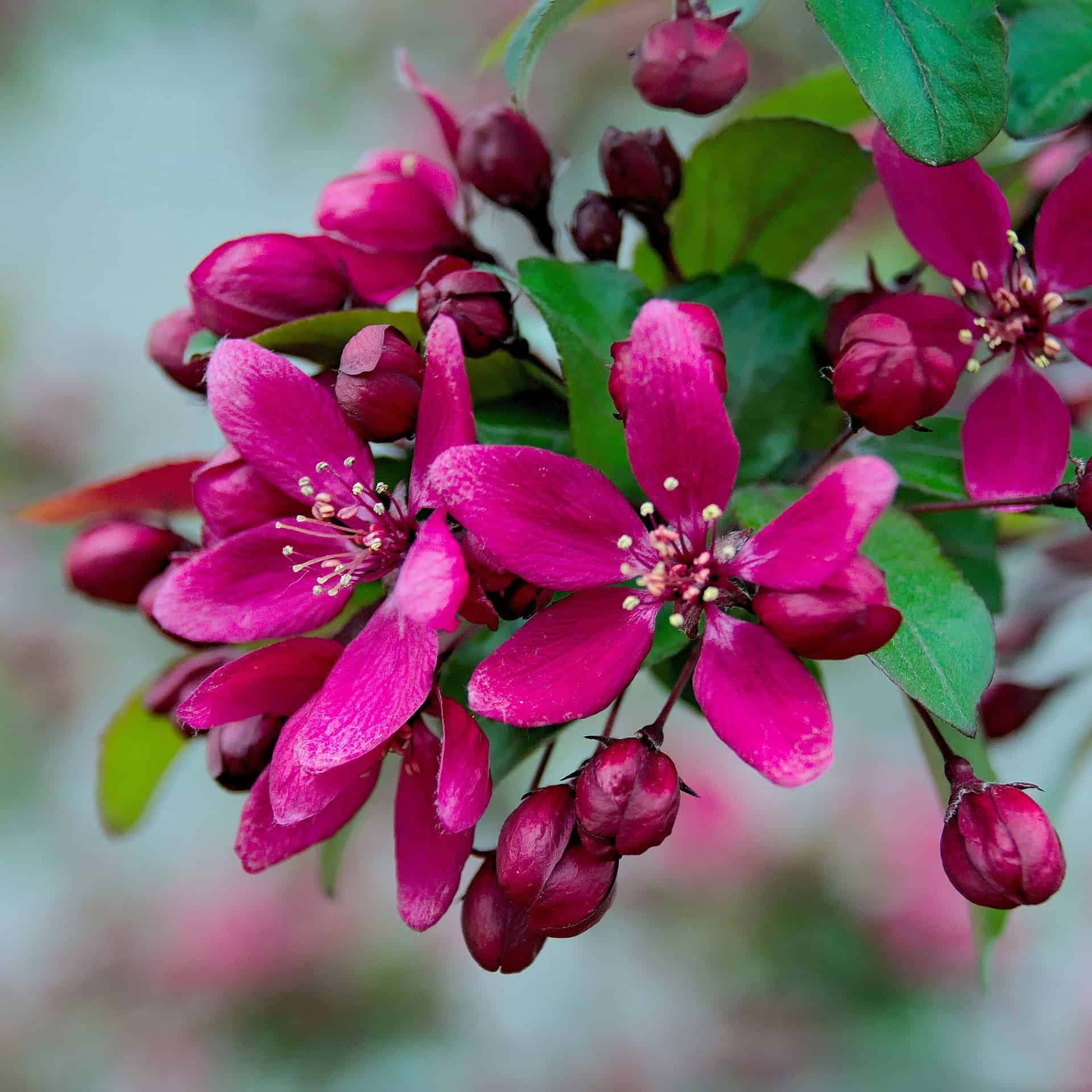
Most of the time, the Royal Raindrops are large trees with low maintenance, making them easy-care flowering trees. The most work you will do is removing the falling berries from the ground in late winter.
This particular plant looks fabulous in a cottage garden, as an accent, or in small groups. The best time for planting is in spring or fall. Also, ensure that your trees have 10-20 feet of space in between.
Planting Crabapple Trees
When you receive your Royal Raindrops Crabapple tree, you must first give the root ball a good soaking. Still, we recommend waiting a bit longer if hard frost is expected.
Start digging a hole at least six inches wider but not deeper than the root ball.
Place the plant in the planting hole and ensure the root flair shows when planted. The best is to add some soil underneath the root ball to provide an upright form.
Once your tree stands straight, you can remove the exposed burlap and metal basket, fill the hole, and soak it with water and again.
To backfill the hole, you can amend the soil with compost and other organic matter fertilizer packets.
Next, backfill up to half of the hole with soil and water well.
Leave your tree to settle and ensure the root ball top is visible.
Next, add some mulch around the base but not against the trunk.
The Best Soil For Royal Raindrops Crabapple Trees
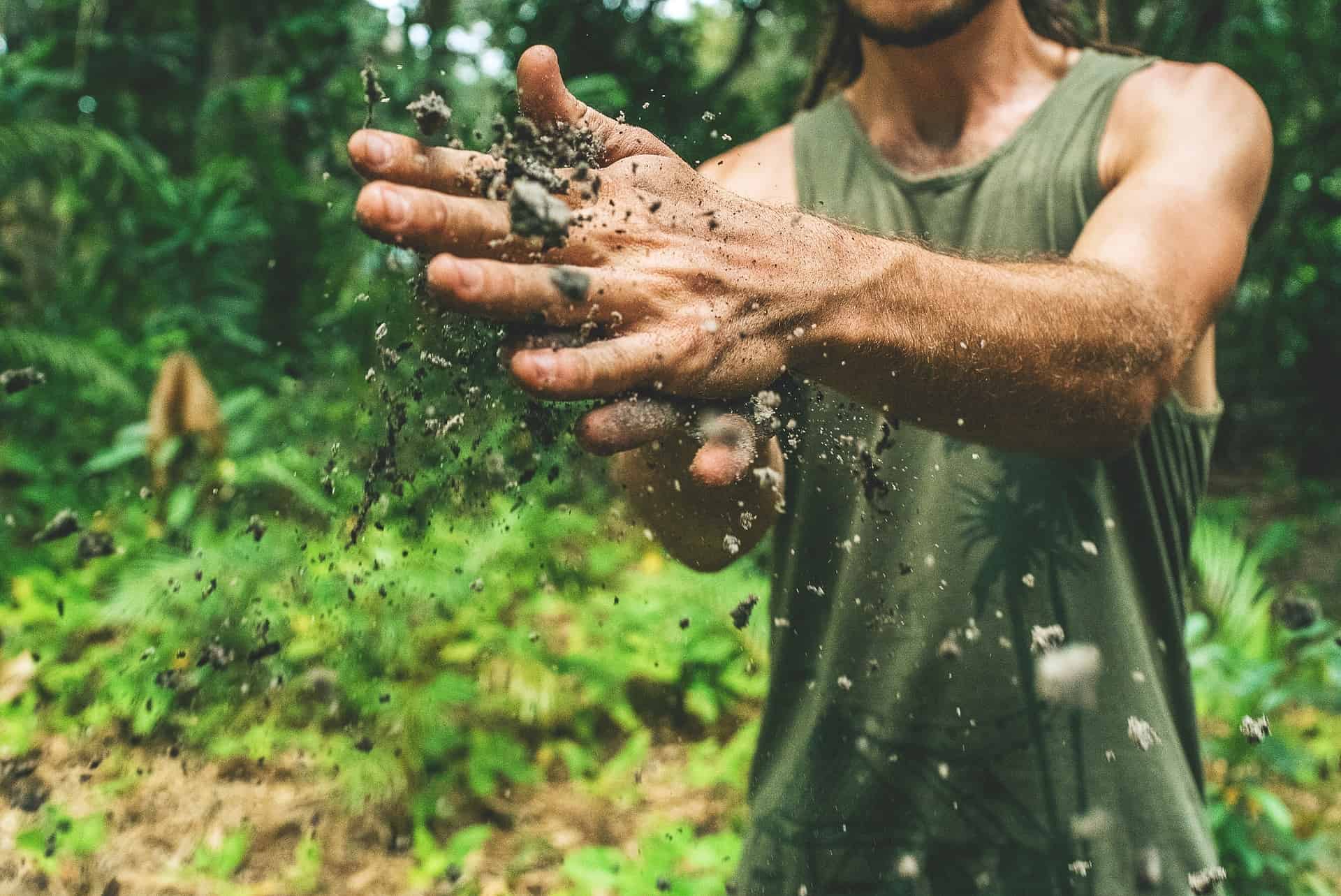
Planting the Crabapple tree, Malus helps to add a lot of organic matter to amend the soil. Doing this gives the root ball nutrients to get a good start and provides drainage.
The Royal Raindrops prefer a slightly acidic soil pH. So the important thing is to provide good drainage for your plant.
You can then complete your planting with some natural mulch to keep the roots cool and retain water.
The Best Spot For Your Crabapple Tree
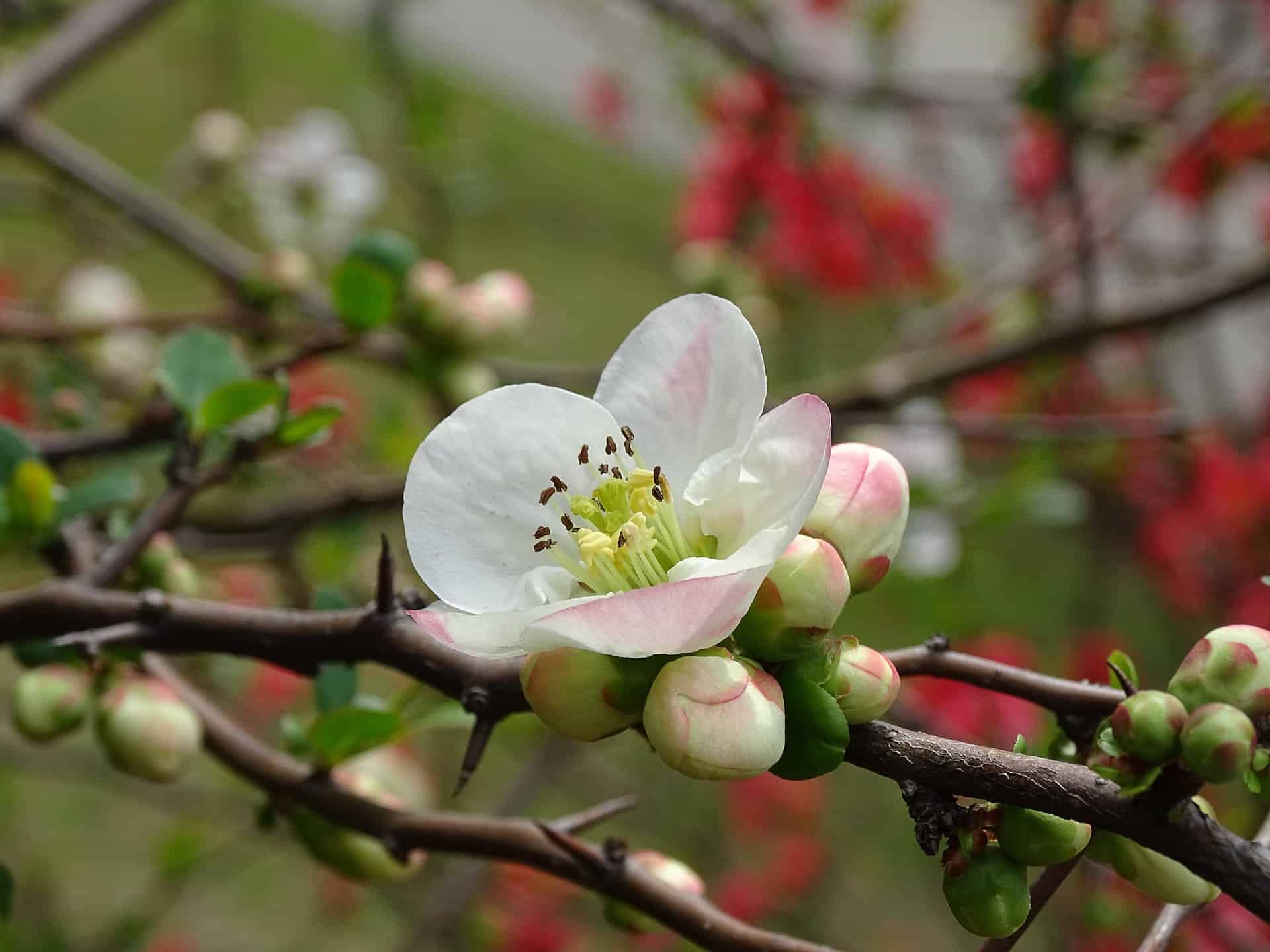
The Royal Raindrops Crabapple tree Malus always needs full sun to guarantee the blossoms in early spring and fruiting later in the season.
You can find some cultivars that can tolerate shade. The Crabapple drought tolerance is high, can withstand the full sun, and is best planted away from other trees.
Watering The Royal Raindrops Crabapple Tree
During the first season of planting, provide your tree with enough water. Once your Royal Raindrops Crabapple trees establish, you will not need to water often unless there is no rain.
While your tree is drought tolerant, give your Royal Raindrops Crabapple deep watering around the base in the morning about once a week without rain.
Important note: Too much rain can harm your Royal Raindrops Crabapple trees’ growth cycle and flower-to-berry production. During the rainfall season, you can place a tarp around the root system to prevent it from getting too soggy.
Temperature and Humidity

While the Royal Raindrops Crabapple tree is drought tolerant, it still grows best in regions where the winters are cold, but the summers are not extremely hot.
The typical growing zone is 3-7. Still, you can find flowering Crabapple trees that can handle the freezing temperatures in zone 3 or 9.
Royal Raindrops and most other Crabapple trees need a winter rest period of 45°F or less and are not excellent choices for hot climates.
With prolonged heat and high humidity, the Royal Raindrops Crabapple tree is susceptible to bacterial and fungal diseases.
Fertilizer For Royal Raindrops Crabapple Tree

When you add some compost or manure around your tree in early spring and some composted manure in late fall with wood chips or pine bark, your tree needs no additional feedings.
Pruning Royal Raindrops Crabapple Tree
The apple trees will benefit from regular pruning to remove dead to broken branches and water sprouts to new growth. But the best time to do this is after the bloom time.
To prune the branches larger than an inch in diameter, wait until late fall using a pruning saw. Avoid spring pruning with a saw as it can open up wounds leading to health concerns with apple trees.
When pruning, allow for ample airflow to reduce the risks of diseases. Also, do not prune away more than 20% of the canopy in a single growing season. Remove crossing branches to allow more sunlight to reach all parts of the tree.
Overwintering Royal Raindrops Crabapple Tree

Generally, you need not protect your Crabapple tree when grown within the hardiness range.
But for young trees, you may want to use metal hardware cloth or some metal basket casing to prevent wild animals from gnawing on the trunks and foliage.
You can also wrap the young tree trunk to prevent winter sunburn for the first few years. Keep the ground around your trees clean of debris and fruit before winter arrives.
Propagating Royal Raindrops Crabapple
Most Crabapple trees are grafted. You can take softwood cuttings to root them, but the specimen might not be as hardy as the parent tree. But you can try rooting the cuttings if you have an undrafted species like the Japanese or Siberian Crabapple. Here are the steps for you to do it:
In early spring, use your sterilized pruners to clip off a 12-inch cutting from the softwood branches.
Remove the lower leaves, scrape the bark’s bottom about 3 inches, and dip the end into the rooting hormone.
Prepare a moist, coarse sand pot and plant the cut end into the soil.
Close the container with a plastic bag, leave it in a sunny location, and keep it moist for about four weeks until new growth occurs.
Once a root system develops, you can remove the bag and grow your cutting in full sunlight.
After a few weeks, transplant your sapling to a larger container with potting soil. When your trees are large enough, you can plant them into the landscape by fall.
Another method is to grow seed, but as mentioned, the tree will not be the same as the parent plant when grafted. But if you still want to try, you can collect the seed from the fruit in the fall and store the seed in a sealed container indoors in winter.
Then sow the seeds in small containers filled with potting soil, vermiculite, or perlite. Barely cover the seed with soil and moisten them, setting them in a warm spot. You can cover the containers with a plastic bag.
Once the seeds sprout, remove the bag and moisten the soil. When the seedlings reach six inches tall, you can transplant them into bigger containers. Pinch the tops back to help with side branching.
Once the seedlings reach 18 inches tall, you can harden them off for a week or two to be planted outdoors.
Royal Raindrops Crapabble Similar Plants
Many cultivars have different sizes and forms of hardiness. Here are some popular ones:
Prairifire
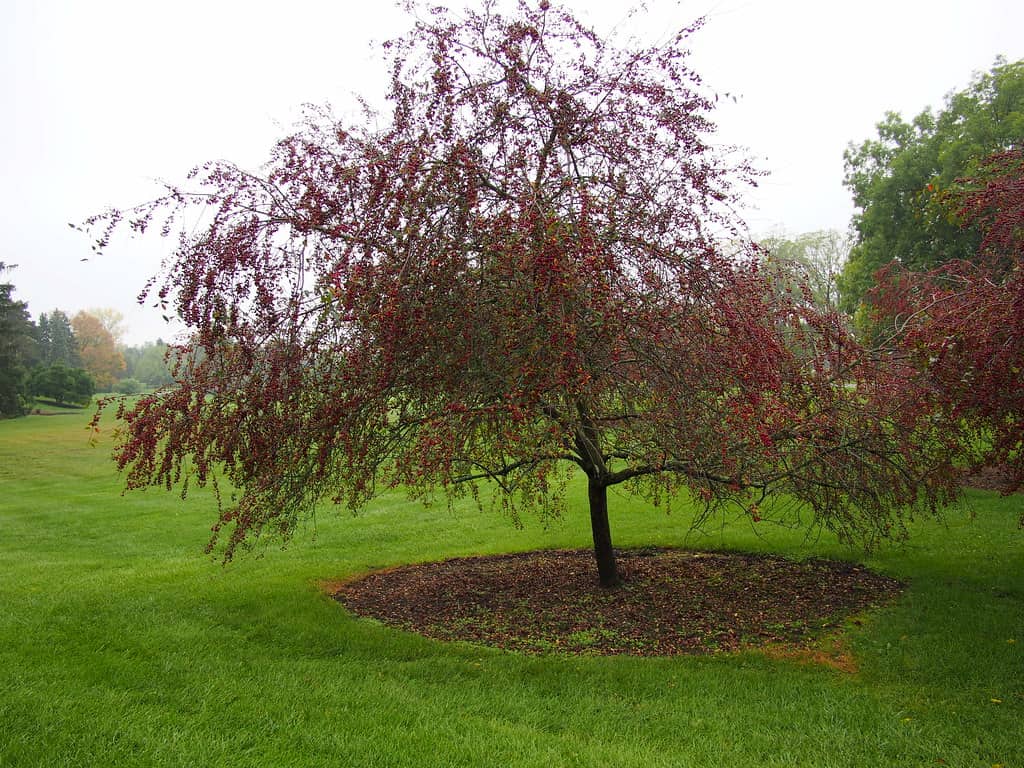 royal raindrops crabapple tree @fdrichards
royal raindrops crabapple tree @fdrichards
The tree has an upright form with dark pink flowers with red-brown leaves growing up to 20 feet tall.
Red Splendor
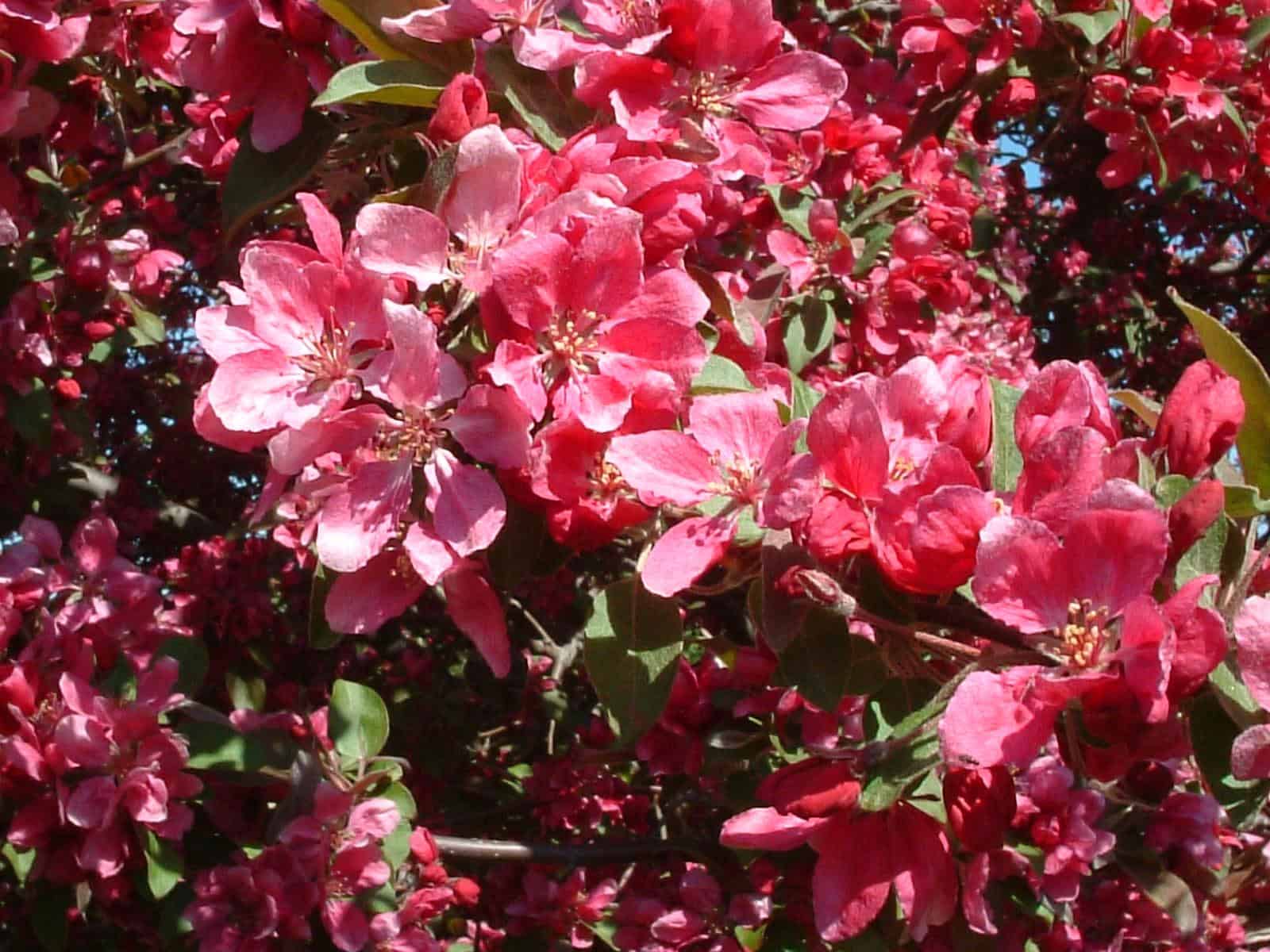
The tree has a spreading habit with a dense form and bright pink flowers with yellow fall color. The tree has excellent disease resistance and is cold-hardy.
Adironkak

The tree reaches a height of 18 feet with white flowers followed by orange-red berries with an upright form suitable for narrow spaces.
Harvest Gold

The Crabapple tree has a wide-spreading habit to use as a small shade tree with white flowers and yellow fruits.
Royal Raindrops Crapabble Common Diseases and Pests
The flowering Crabapple has pest and disease resistance against aphids, the Japanese beetle, tent caterpillars, and even powdery mildew. But as the saying goes, nothing is impossible, and you still need to keep an eye on your tree for the following common Crabapple diseases:
Fire Blight
The disease results from the bacterium Erwinia amylovora. You will start noticing oozing wounds on the tree bark that blackens, and the foliage looks burned.
Here sanitation is essential to prevent the spreading of this disease. But, unfortunately, there is no cure.
To prevent it, do not fertilize with feed high in nitrogen around the tree’s lawn areas or underneath the tree.
Apple Scab
The fungal disease causes olive-to-black spots on the fruit and leaves. You see the symptoms starting in May or June. With prolonged wet weather, it hastens the infection. Hence, it is important to keep the grounds around your trees clean and use a fungicide when you start noticing the symptoms.
Powdery Mildew
Another fungal disease that forms a white powder on the leaves but does not cause lasting harm. With regular pruning to provide air circulation, you can prevent this disease from causing unattractive foliage.
Also, look out for these common pests on your tree, as nothing is impossible:
Mites are reddish when on the twigs, followed by wilting leaves. Smothering insects and eggs with neem oil is the best remedy.
Aphids feed on the leaf juices and are often spotted by the black mold growing on the foliage. Again, spraying with insecticidal soaps or oils is a helpful treatment.
Japanese beetles will chew holes between the leaf veins, giving them a skeletonized look. The best is to ignore Japanese beetle damage unless severe. Beetle infestations are cyclical, and the populations do not persist year after year.
Appletree borer is the Chrysobothris femorata beetle larva stage. The worms attack young or weak trees. First, they bore into the main branches and trunk, leaving cracks in the bark. Eventually, it can encircle the limb or trunk, killing the main branches or the whole tree. Unfortunately, no remedy is available, and the only way to fight the disease is to keep your tree healthy.
Frequently Asked Questions
The only difference is the fruit size, as the Crabapple tree produces small two-inch or less fruit than the apple tree.
The fruit of the Crabapple tree is loaded with vitamin C to help build a robust immune system. So, enjoying the fruit will help fight off illnesses.
A Crabapple tree with uninteresting fruit can turn into an apple tree using the grafting method.
You can, but you must plant the tree at least 15 feet away from the foundation as it allows the canopy to mature fully and provide shade.
The tree is available at your local garden center, or you can find one here with Plantly online to deliver to your home.
Whether you want to buy, sell, or simply reach out to other plant enthusiasts, Plantly is the right place to be!


